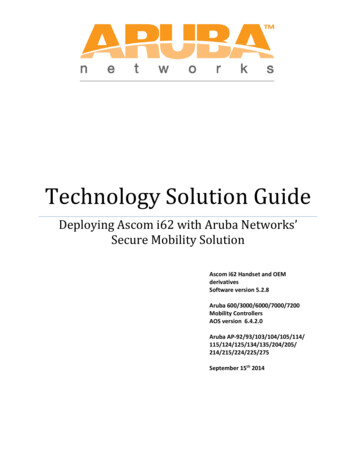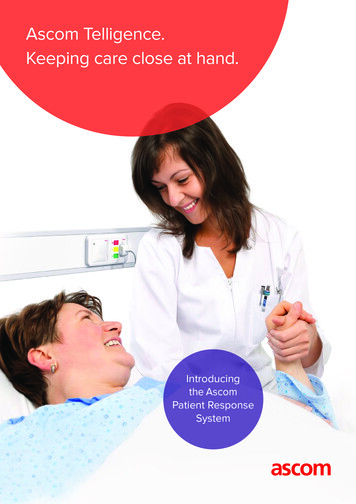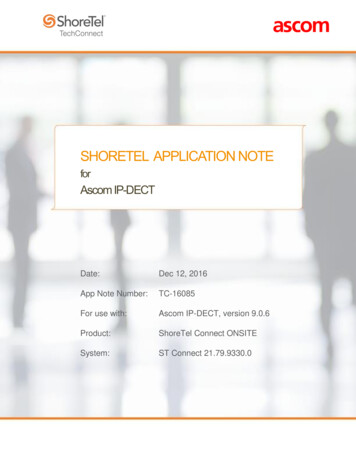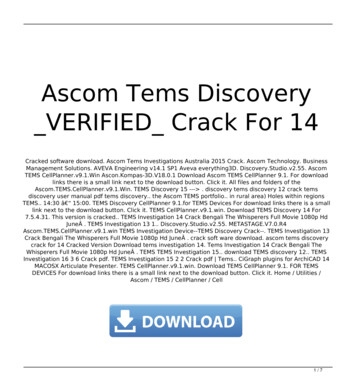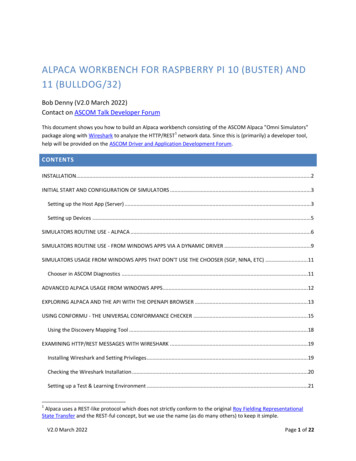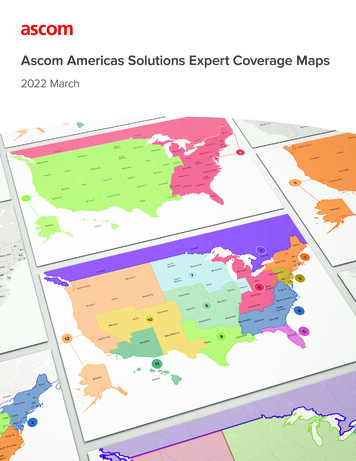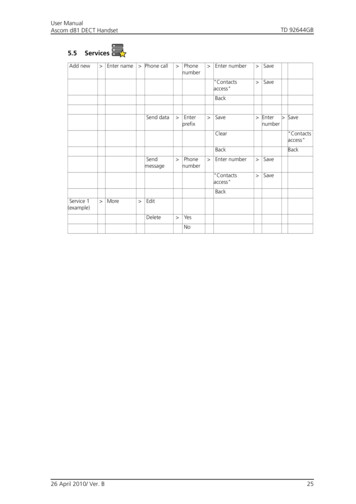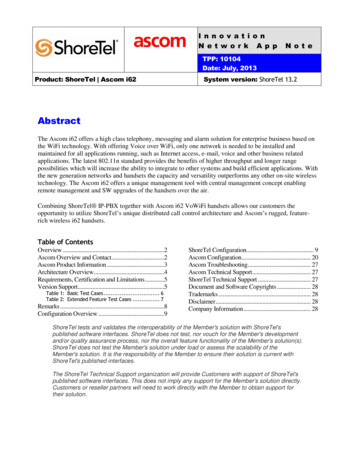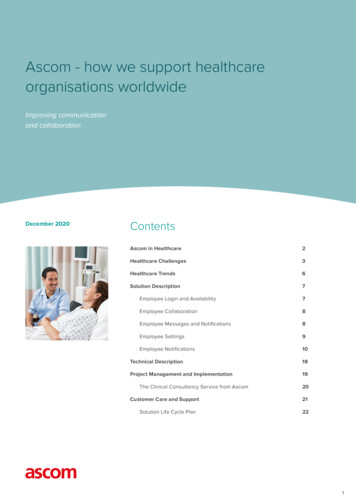
Transcription
Ascom - how we support healthcareorganisations worldwideImproving communicationand collaborationDecember 2020ContentsAscom in Healthcare 2Healthcare Challenges 3Healthcare Trends 6Solution Description 7Employee Login and Availability7Employee Collaboration 8Employee Messages and Notifications8Employee Settings 9Employee Notifications10Technical Description 18Project Management and ImplementationThe Clinical Consultancy Service from Ascom1920Customer Care and Support 21Solution Life Cycle Plan221
Ascom in HealthcareYou already know about the challenges facing the healthcare sector. Youknow about aging populations and budget constraints. You know aboutrising patient expectations. In addition, you probably know how hard it’sbecoming to attract and retain top-class employees.You might even know that Ascom, for more than half a century, has beendeveloping mobile communication solutions for the healthcare sector. Weare constantly dedicating more and more resources and innovation tosupport the growing demands of the sector.Are you aware about how those challenges may be impacted by a communicationplatform created specially for healthcare organisations?Read on to discover how the Ascom Healthcare Platform can help you andyour colleagues solve some pressing problems. Find out how we work in real,demanding healthcare environments. This document only scratches the surface ofthe full potential of the Ascom solutions.2
Healthcare ChallengesPopulationsPopulations worldwide are rapidly aging, straining already limited resources. Itis not only restricted to the world’s most developed nations. Ageing populationsand with this an increased number of chronically ill patients leads to demand forefficiency in all stages of the care chain. There is a great need for more efficient,highly coordinated care.DigitzationDigitization of healthcare is an important factor in meeting the ever-increasingneed for resources. Ascom's solutions enable effective mobile working includingimproved communication between staff and patients.A globalized economyA globalized economy means disease outbreaks spread quickly, overwhelmingnational health systems. The growth of global trade and travel means, “a localizedepidemic can transform into a pandemic rapidly, with little time to prepare apublic health response”. Outbreaks can challenge even the most sophisticatedinternational responses, as evidenced by the Covid-19 pandemic.How do you protect patients from infections without isolating them and not riskingthe patient safety while taking the patient’s wish for greater interaction andcommunication into account? Ascom's solutions provide smart communicationbetween patient and staff that can help to reduce the number of trips in and out ofthe isolated area for the staff but also increase the service for the patient.Workplace violenceWorkplace violence is a constant issue for healthcare staff, affecting both staffand patients. The main challenge is that the violence against staff has not only anegative impact on the psychological and physical well-being of the staff, but alsoaffects their job motivation.Physical and verbal abuse against caregivers is widespread. That is why a personalalarm system is essential in today’s healthcare sector.Ascom staff protection solutions enable fast, accurate and coordinated responsesto personal safety alerts. Such alarm notifications can even be sent should amember of staff lose consciousness or otherwise be unable to transmit an alert.Patients and relativesPatients and relatives become 'specialists' in their own disease because they haveaccess to information. This not only raises expectations for high-quality care, itlets patients learn about their conditions and treatments, and makes it possible for3
them to become more active members of the care team. Such collaboration canbe hugely beneficial—provided there are communication systems in place thatfacilitate information sharing.Ascom response systems enhance and personalize the communication flowbetween nurses and patients. This empowers patients by giving them more controlover their immediate environment, and more information about their hospital stay tohelp achieve patient satisfaction.Staff communication and collaborationPoor communication is one of the biggest problems facing hospitals today.Ineffective communication can lead to many issues: improper diagnosis, delayed orimproper treatment, patient insecurity and stress. Without proper communication, itis harder for care teams to be continuously up to date.Ascom enable staff collaboration by providing role-based communication support,staff availability status and efficient means of collaborating around the patient witha mobile way of working.Inadequate face timeNursing shortages and administrative workloads mean nurses have less and lesstime to devote to each patient. This lack of ‘face-time’ can impact clinical outcomesand patient satisfaction levels.Ascom provide point-of-care solutions that make it possible for caregivers toperform tasks and receive patient and clinical data while remaining with a patientat the point of care. Clinical data sources have traditionally been static. Ascommakes them as mobile as possible for the people who use them and provide addedconfidence that they can remain in close contact with them when they leave thepatient room.Alarm hazards and alarm fatigueAlerts that do not reach the appropriate staff, or an excessive number of clinicallyinsignificant alerts, can cause ‘alarm fatigue’. This can lead to staff missingimportant alerts, or deliberately disconnect equipment in order to gain a respitefrom unnecessary alarm notifications.Ascom solutions help minimize clinically insignificant alerts. Alarm notificationsare filtered, grouped and targeted only to assigned caregivers in pre-assignedescalation chains that supports a mobile way of working.Discontinuous carePatients stranded in wheelchairs, waiting for porters to wheel them to anotherward or department; delays and misunderstandings at shift handovers; constantstaff changes that make it difficult to create relationships between caregiversand patients. Discontinuous care can make a stay in hospital a frightening anddisorienting experience—especially for the elderly and the mentally ill.4
Ascom solutions help optimize patient pathways within and between departments.We provide hospitals with communication and workflow tools that are integrated tosupport a mobile way of working.Inadequate management dataInformation is power, and nowhere is it more powerful than in hospitals. Theproblem is how to collect, store and distribute huge amounts of data in ways thatcan yield valuable results.Ascom solutions for data analysis can help hospital managers and administratorsimprove workflows, enhance patient safety and reduce costs. They can, forexample, help managers or administrators investigate accidents and incidents.They can help customers track and analyze key performance data in order toidentify and address inefficiencies.5
Healthcare TrendsPatient TrendsPatient safety and satisfaction are key. This is due to a variety of factors such asthe increasing awareness of the patient and relatives, the technical and economicdevelopment of society and the increased travel of people. For example: Patient satisfaction is reliant on providing a reliable, easily accessible, anduser-friendly patient environment with short communication lines and personalinteractions. Patient safety often focuses on single patient rooms for a calmer experience,protection from infections but still provide patient safety. This could be done withmonitoring solutions both in care environments as well as at home.Staff TrendsStaff empowerment and mobile working are key. Improving staff collaboration to limit issues like improper diagnosis, delayedor improper treatment, patient insecurity and stress. Nursing shortages andadministrative workloads also means nurses have less and less time to devote toeach patient. Improving communication between staff and patients helps to keep patients upto date and give staff the opportunity to provide a more precise service. Providing the right information at the point of care where the staff meet patientsis also more and more important to limit the issues of improper diagnosis,delayed or improper treatment, patient insecurity and stress.Technology TrendsDigital transformation and interoperability. Consolidation of hospital ICT systems,consolidation of hospital EMR systems, AI and Big Data analytics. Consolidation of hospitals’ ICT systems demands enterprise-level software thatcan serve multi-site installations. More data is being captured and shared than ever before. Is this is a good thingwhen it comes to healthcare? Yes, because the more information healthcareproviders have about us, the more accurately they can predict, and the more BigData companies can start using this knowledge to predict when people will getsick. As quality data and consumer and patient trust increase, AI will become morereliable. It is possible that in future a computer can be more accurate in making adiagnosis and determining treatment. While trust in technology is rising, it will be dependent on the actions we assuppliers take to demonstrate integrity and put consumers at ease. Another clear trend is smartphone apps with a vendor neutral approach tomobiles devices and peripherals. We can also see more light-weight solutions where you can adapt the solution tothe user's needs in a relatively simple way.6
Solution DescriptionEmployee LoginThe employee logs onto a mobile device whenarriving on shift.Employee AvailabilityThe employee becomesavailable for collaborationand notifications.Employee CollaborationThe employees are able tocollaborate with colleagues.Employee Role AssignmentsThe employee becomesavailable for the actual roleassignments.Employee NotificationsThe employees areavailable for all notificationsbased on role assignment.Employee ViewsThe employees are allowedto access all relevant viewsfor the actual roles assigned.Employee Login and AvailabilityThe Ascom platform is open, flexible and user-friendly and designed tosupport employees' workflows and manage the events they encounterevery day.In our smartphone application, we distinguish between alerts, alarms andcollaboration between employees as well as tasks to be performed. Bettercommunication between employees at work provides better utilization of resourcesand unnecessary extra work in finding colleagues and giving messages.The employee log on to a mobile device when arriving the shift. Employees arethen assigned a role automatically or manually select by themselves. The solutionis based on the assumption that employees have a role that has one or morefunctions in the department and the hospital. Employees will then be given thestatus of logged in and available. When an employee is logged into the system,the others will see the role, title and availability. In the mobile app, employeescan search for colleagues by name, role, title or team. The solution supports thecreation of teams so that a group of employees can have their own group chat.Integrations with other professional systems are an important factor for acomprehensive solution with less work and better security. We expect a singlesign-on functionality to be used for authentication.When staff leave a shift, they log out and the directory is updated to release devicefor other users. The solution can be configured with a "must be manned" role andprevent logout before replacement is in place or give notice of lack of staffing onrole.The system have built in support for active RTLS (real time location services) andsupports use of mobile devices* without the need for additional wireless tags. Thesystem also work with third party RTLS platforms.When staff enter a predefined area, a series of events can be activated. Forexample: automated room presence, complete with overview of role and staff ID7
automatic nurse presence on nurse call systems automated alert suppressing of tones for medical alerts received for samelocation automatic access to tasks nearly due for this specific location.Employee CollaborationEmployees often work in teams with their patients. Therefore, it oftenmakes sense to communicate around the individual patient or team.With patient-centered communication, staff have a better overview of thecommunication around the individual patient. Employees can then more easilycommunicate with more correct resources at the shift.All information for the application is encrypted. Which patient or team an employeehas access to is controlled by the role the employee has at that particular shift.When logging out of the application, all information on the smartphone will becomeunavailable.Employee Messages and NotificationsThe Ascom Healthcare Platform (AHP) enables fast and secure distributionof information, notifications and alarms. The AHP uses a uniquecombination of presentation methods to support prioritization of receivedinformation by the individual user in the system. These methods is used tosupport decisions, based on access to information, in the hand of the user.When notifications are distributed to a mobile user the Ascom UAX app will presentthe content for the user via meaningful text, color coding, self-explaining icons andaccompanied by a tone that indicate the urgency of the notification – even withoutthe need for reading the notification. Parameters for message handling can be setfor message types and user groups in configuration.There are three categories of messages the staff can receive: alerts, chat messagesand tasks - each of which is handled in its own section of the app.The alert view contains logic in the individual department of who should havenotifications and escalations. Only active alerts are presented to the user.Employees can actively escalate, reject or let the system handle it automatically atredefined response times.The alerts are presented according to time and criticality. Employees do not haveto actively search and find alarms again as they are repeated until cancelled by thesystem itself, or when alarm state is cancelled at the source of the event.For example, patient call will be cancelled by room presence or patient monitoralarm disabled by monitor staff. If the system that sends an alarm does not havethe opportunity to delete or cancel the alert, a predefined time will then be definedin the integration as long as an alarm is presented. All alerts will be stored in thedatabase for subsequent analysis. It is only information in the application of theindividual employee that it is removed.Chat messages can be one to one between staff, patient centered or team based.All messages are stored in chat history and made available. All messages arestored in the database for analysis. How long the history of the chat should beavailable is configurable. For example, for each patient, message history will be8
available for the duration of the patient's stay in hospital. How long the history isin one by one and in teams in the application can be configured as desired for theindividual department and guidelines for the customer.Tasks can be assigned individually to the individual role or team with a deadline forwhen the task is to be performed. Employees are notified in the application when anew work assignment arrives or when a task has exceeded the deadline.Employee SettingsThe smartphones application can be customized for users with specialneeds. For example, those with poor eye sight may have customizedsettings in the platform. Filtering all alerts to the correct role at the righttime with appropriate escalation routines significantly reduces the numberof alerts and alarms.Reviewing which alerts the staff needs and how the department works with thepatients is an important element in reducing the number of alerts the individualemployees receive.We find it important that employees have the right use and focus around the mainsystems against which they are integrated. For example, it is important that staffreset patient alerts in patient rooms.Employee ViewsThe Ascom Healthcare Platform offers information overviews for both mobileand stationary use. As different information is important for different roles theplatform offers different views that can be combined to provide flexibility to healthenterprises, clinics, departments or similar.Ascom's clinical consulting is a natural starting point when planning a new unit, anew hospital or a new technical solution. Hospitals do not need to have an Ascomsystem/solution to benefit from the clinical consulting service. In fact there is noneed to have any system in place, and the service can be used when designing asyet unbuilt facilities. Or you can opt to use the service to solve specific issues suchas alarm fatigue or unsatisfactory alert response timesCare LevelsACaringwardStable with need for sub-advanced medical treatment Basic nursing No life support by medical device Vitals check x 1-4/day Some use of infusion/volumepumpsBEmergency Unit,Post-Op Unit, HeartIntensive Unit, StepDown UnitCIntensiveCare UnitCould be critical condition Basic to advanced light nursing Some need for continuous monitoring No need for life support bymedical devices Use of infusion/volume pumpsCritical condition Advanced nursing Continuous monitoring Need for life support by medicaldevices Multiple use of infusion/volumepumpsDORTheatreArtificial coma under invasive procedure Advanced nursing Vital checks from every minute to five Full/part life support by medicaldevices Use of infusion/volume pumps9
Mobile ViewsOn the mobile device the main view is the list of alerts and messages. From hereyou will always get an overview of the most important things that needs to behandled. Within each alarm or message it is possible to get more information fromthe source of information. The smartphone app links directly to other apps withoutmanually opening and re-typing information (also applies to third party apps). Fromthe overview, it is possible to add different functions on predefined tabs.You can add views for tasks, chat and medical device integration.The flexibility also offers roles focusing on one view, e.g. service tasks, to haverelevant information on their main overview.Stationary ViewsOverviews for workstations or large displays contains information about who ison duty, who is set up with different types of responsibilities, such as coordinatingnurses, supervisor for the various medical disciplines, responsible nurses at thevarious posts. It is also possible to enable administration of assignments.Additional views could be: Medical devices (near-real-time data with vitals and trends) Logistic information, transport and service Rounds, turning patient Critical alerts status Building alarms status (fire etc.) Personal alarm status (on-site and/or off-site) Coordination statusEmployee NotificationsThe Ascom Healthcare Platform is a scalable and modular platform, whichenables fast and secure distribution of information, notifications and alertsaround the healthcare environments.OKAcceptRejectOKTraumaWard 1,Blue CorridorAreaECGAnna P. (R1 S1)AcceptPersonal AlarmEmily BlueCorridorLunchAGV StationLABUID 12345OKRejectCleaningR7 S1AcceptRejectPostboxPIN 12345OKInfusion PumpPer P. (R6 S1)Normal CallStefan J. (R3 S1)AcceptAcceptRejectRejectWardSamplePipe Post StationWaterUf A (R4 S1)AcceptRejectOKDoor BellBlue CorridorAcceptRejectOut of bedJohanna B (R5 S1)AcceptReject10
Typical notifications/alerts could be: Patient notifications Logistic notifications Service notifications Critical notifications Clinical notifications Building management notificationsWhen a new source are integrated to the platform the importance of messagesneed to be weighed against other messages/alarms. For lower prioritizedmessages it is also advised to set a limit of the expected message flow, e.g. onlyone notification per second from the AGV system will be processed.Patient NotificationsWhen handling nurse call it is all about taking care of the patients needs in the bestpossible way while keeping disturbances to a minimum.When using mobile notification we facilitate a direct communication betweenthe patient and the assigned staff and can enrich the nurse call message withadditional information about the patient through integration to EHR (ADT feed). Thiscould be Name, Gender, Location, Precautions and other information, which thestaff could benefit from in a nurse call situation.The Ascom solution have an expandable work surface where you can add uppatients and get a fast overview of all the equipment connected to each patient onthe unit.By clicking on the patient you will get trending data and the possibility to open upPACS/RIS, LIMS, and more. It is also possible to get as a mobile application, onmobile devices. This is a solution where you are given the possibilities to registerVital Values data directly into balances scorecards set by the hospital, with directtransfer to EPJ.If the nurse call system provides two-way speech capabilities, the system willenable the staff to establish a direct voice communication from the mobile deviceto the patient room or bed in multiple bed rooms. This will identify the patient’simmediate needs to support their prioritization decision or to bring supplies to thepatient.With this method, we shorten the communication path between patient and staff.11
Logistic NotificationsWe can capture any type of event which can be received in a structured formatand transform it into a structured task and notification flow. This can be based onnotification type and/or location and implemented to support on individual needs.Task ManagementOur platform is flexible and can be adapted to the customer’s needs to handletasks that must be performed. At the same time collecting of data for all the tasksperformed leads to a data-driven optimization of staff and tasks at any given time:This includes task management for:1. Service organizations, e.g. patient transport, cleaning and logistics.2. Nursing wards with more patient-related tasks such as dressing, wound care,rounds, etc.The platform contains all the necessary elements to handle the various tasks thatexist in a hospital, including ordering, coordination, prioritization and execution oftasks, as well as follow-up and optimization of the implemented task flows.Although the platform contains all the necessary elements for ordering, we believethat it is advantageous to consider extending the need for integration to existingclinical systems in order to optimize order flow in connection with, for example,radiology functions and similar needs.It is possible to create predefined types of tasks that are adapted to the business ordepartment to support. It makes it easier to create new tasks and makes it possibleto ensure a uniform execution of the task.Some examples of tasks that can be created: Transport of patient to bed (adult) Transport of patient to bed (children) Transport of a patient in the presence of a doctor Transport of patient in a wheelchair Transport of a patient at risk of infection Provide unclean bed Get clean bed Pick up / deliver equipment from / to warehouse Pick up special mattresses Handle arrived goods / mail Handling of food transport Collection / delivery of samples12
The content and workflow of the task type (rules for how they are created, assignedand performed) are adapted to the organization that will perform the task. Thisincludes rules for automatic assignment, manual assignment and whether it ispermissible to override the automatic assignment.If the organization is a service organization, the types of tasks they own can beconfigured so that other organizations can order assignments from them. When atask type is made available to others, the task type appears in the list of tasks theycan order.In the configuration interface, the tasks' mutual order and prioritization are defined.This will ensure that patient-related tasks, where personnel have an agreementwith the patient at an agreed time, are always given high priority and can be used inconnection with examination and surgery. If it is ensured that the patient arrives ontime, the risk of delays and canceled examinations and operations is minimized.Critical NotificationsAll types of critical alerts such as trauma, cardiac arrest or sepsis could be handledin the platform. When activated, the emergency alarm is sent out to the variousfunctions of the alarm team with an acknowledgment request. The recipientacknowledges and runs to the location specified in the message. If the recipientdoes not acknowledge, the alarm will escalate according to predefined list offunctions. The process is monitored by an operator who receives proceduresduring the process if defined.Using a simple and intuitive user interface, the solution supports the operatorin the management of critical alerts. The various steps have been predefinedin collaboration with the end users, so that the solution uses the most possibleautomation and default values. This means less stress and increased security incritical situations.The alarm operator interface gives the operator an overview of all active alarmsand their status. When a critical event is triggered, the solution shows instructionsthat the operator must follow. The instructions are structured and pedagogicallyarranged with symbols so that it becomes easy for the operator to get an overviewand be able to prioritize. During ongoing alarms, the operator also has access to aprocedure list in the client where the specific activities of the alarm are presented.These activities are those that the operators must perform because the alarm isactive and or before it can be shut down from the client.For example, in the case of a potential diagnosis of sepsis, the nursecan trigger a “Sepsis notification” from their smartphone. This flow ispreconfigured and deployed for a group of users and devices. Whenactivated, the nurse can add information about the patient – for example, theroom number, observations, Early Warning Scores and similar – then activate.This triggers a notification flow that is sent out to a chain of recipients withrequest for confirmation. When the recipients accept the notification theinformation will be updated with different options (for example, trigger bloodsample, ask for Sepsis team or notify ICU) based on the workflow for Sepsis.13
Sepsis Mobile WorkflowWhen a user selects an option in thenotification message, the option canalso trigger new options. Inthis way, a workflow can beprogrammed for a specificcondition and handled in amobile device.1. Nurse checking thepatient's vitals via the 'VitalsApp'.2. Nurse uses 'My Services' toalert the Charge Nurse aboutthe potential sepsis.Based on the values enteredthe patient gets an EarlyWarning Score 7This by using positioning ormanually adding location orpatient details4. After seeing the patient,the Charge Nurse decides toalert the sepsis team via theNotification Message.5. The sepsis team receivean accept the sepsisNotification Message.3. Charge Nurse is notifiedabout the potential sepsiswith Notification Message.She accepts and goes tovisit the patient.6. The sepsis team arrive tothe patient and makes anassessment.When a user selects an option, the option can also trigger new options. In this waya workflow can be customized for a specific condition and handled in a mobiledevice.Similar processes for clinical procedures like Infection Hazards, Scoring and Triagescan be digitalized with support of a mobile way of working.Clinical NotificationsThe platform can receive/subscribe to ADT feeds from the DIPS EHR system orsimilar central source of information. As the ADT block can contain valid and usefulinformation that might be used in various situations the information is stored forthe specific location. The requested feature to display infection risk is importanthowever more common precautions could be allergies, fall risk, special needs andsimilar. Those precautions will be added as supplementary information to nursecalls, alerts and notifications as well as displayed on the user’s smartphone for easyaccess. The precaution will enable faster and improved decision making when staffneeds to prioritize.Test results: When the system is notified that a test result is ready, the system willlook for the settings made for the organization and send the information to the rolesconcerned. The roles to be notified is configured in the system on an organizationlevel. Different type of test result can be sent to different roles. In addition, anotification can be displayed on screens.Building NotificationsThe solution handles all types of building alarms like fire, fire doors / shellprotection, security systems etc. When activated, the emergency alarm is sent outto the various functions of the alarm team with an acknowledgment request. If therecipient does not acknowledge, the alarm will escalate according to predefinedlist of functions. The process could be monitored by an operator who receivesrelationship orders during the process if defined.Using a simple and intuitive user interface, the solution supports the operatorin the management of building alarms. The various steps have been predefinedin collaboration with the end users, so that the solution uses the most possibleautomation and default values. This means less stress and increased security incritical situations.14
The alarm operator interface gives the operator an overview of all active alarmsand their status. When a building alarm is triggered, the solution shows instructionsthat the operator must follow. The instructions are structured and arranged withsymbols so that it becomes easy for the operator to get an overview and be able toprior
Information is power, and nowhere is it more powerful than in hospitals. The problem is how to collect, store and distribute huge amounts of data in ways that can yield valuable results. Ascom solutions for data analysis can help hospital managers and administrators improve workflows, enhance patient safety and reduce costs. They can, for


